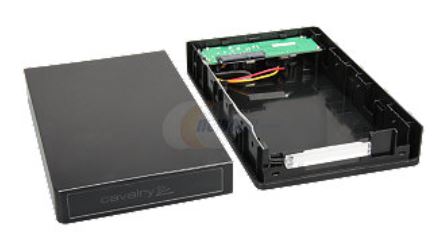External Hard Drive Enclosure
Putting the drive in an enclosure is real easy. Most if all the enclosures use USB to connect the drive to the computer. Some will be USB 2.0 and some will be USB 3.0. USB 3.0 is the newer version. To use 3.0, you have to have a USB enclosure that is 3.0 and a computer that has 3.0. However the 3.0 is backward compatible. If your enclosure is 3.0 but the computer is only 2.0, it will still work, just won't have the speed of the 3.0.
Once the hard drive is in the enclosure, the drive is easy to access. You just simply plug it in, the drive will create a drive letter and it will be ready to use. You can just open My Computer to access the drive (it may open automatically when you open it)
When buying the enclosure, take note of the type of hard drive that you got. There are two types of hard drives
-
IDE hard drives - older style hard drives
-
SATA hard drives - newer style hard drives
For information on determining what kind of drive that you have, click here.
If you have an IDE hard drive, you will need to buy an external hard drive enclosure that is for IDE. If you have a SATA drive, you will need one that is for SATA.
The cost of the enclosures are from $7 to $100 depending on the features it has.
 |
The picture is an example of an external hard drive enclosure. You just plug the hard drive into the cables, put the cover on the enclosure (Some have a plastic sleeve to go between the cage and the hard drive. Very important to install), and plug it into your computer
I would recommend an external hard drive enclosure that has a power supply of it's own. If it doesn't, it will use the power from your power supply of the computer. If your power supply is weak or going bad, it may not function properly.
NOTE: some of the low end enclosures (Talking about cost) are not recommended for use with hard drives that are going to be left on for a period of time. If you use a low end, be sure it handles heat well. Some will overheat and damage the drive.
Once you have it setup, you can use it on any computer that has a USB port. Click here for information on what a USB port is.
Some information you need to know
-
If you are using a hard drive that is formatted in NTFS, it will not work in a system that is FAT32
-
Windows 98, Windows ME is in FAT32
-
Windows XP can be in either NTFS or FAT32. Most are NTFS
-
Windows Vista, Windows 7, and Windows 8 is in NTFS
-
FAT32 can only go up to 2 GB.
-
NTFS can go up to several TB (which is bigger than 2 GB)
If you decide to format the drive, Determine the type of computers you will be plugging the hard drive in and how much data you will be storing on it.
Tip, if you want to setup an automated backup system to automatically back up your system without you having to remember to do it, you can use Karen's Replicator. It is free.
Here is information about trying to open a file created on a different computer.
